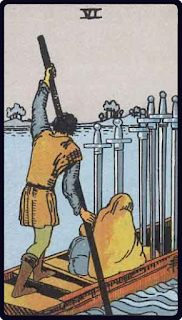
Representing transience and movement; the 6 of Swords is associated with endurance and consequence. In the wake of conflict reality persists, life goes on and the impact and legacy of that conflict endures despite the cessation. Long after the conflict itself is forgotten to history the impact will still be felt even if the significance and the origin is not understood by those who endure.
In the upright state the 6 of Swords represents our need to accept and move beyond conflict. To accept the past as written, something we cannot change, but to embrace the present as an opportunity to shape the future and decide upon the direction of travel both in how we view our past and how we let it shape our future. We may not be able to change what has happened but we can choose how we respond to the past, and the mindset we wish to adopt going forward. Holding onto past conflicts perpetuate their negative influences, whilst drawing a line under them gives us the opportunity to reach new destinations.
In the inverted state the 6 of Swords explicitly represents this loss of potential when we hold on to conflict, whilst no longer engaging in that conflict it still governs our thoughts and informs our actions and ultimately controls our lives. The inverted 6 of Swords therefore emphasises the need to seek closure in order to overcome our inability to let go and to move forward. Where the upright state looks forward and emphasises optimism, the inverted state looks backward emphasises our need for closure.
In the Rider-Waite deck a family cross a body of water in a boat. To their right the water is disturbed and to their left it is calm indicating their pursuit of tranquillity and peace. The family carries with them 6 Swords stood upright representing the legacy they retain. The mother and child sit in sorrow, the father stands with oar in hand attempting to navigate the waters and maintain forward momentum.
In self-reflection the 6 of Swords serves as a prompt to consider what is dynamic, what has changed in our environment or even what has changed within ourselves. When we discussed auditing the sources of positivity and negativity that affect our internal state this was done in the context of our environment at a fixed moment, or static frame of reference, a day, week, or month as examples were given.
Transience requires that we recognise that our environment changes, and what might have once been a source of positive influence can in time become a source of negative influence and vice versa, with the transition potentially imperceptible if it is gradual and prolonged. This also applies to the people in our lives that we maintain connections to, and our sense of self.
We are encouraged to ask are we still the same person or have we changed, and ask the same of those we engage with. Ask yourself “Is this still good for me?” or “Are that still good for me?” and take the opportunity if needed to revisit your past approach to auditing these influences. Different approaches will serve us better at different moments of our life, and our changing environment.
With other people in particular it is important to recognise that other people grow and change over time, someone who may have once been a positive influence may no longer serve that role. We all have our own set of life experiences and even when those experiences are the same, our reactions to them can be fundamentally opposed to one another. As a recurring theme we are asked to consider who they are now and who they have become, as opposed to who they were – and in the case of introspection who we have become as opposed to who we were. The sense of obligation to our sense of nostalgia and desire to hold onto past perceptions can often blind us to dangers in the present.

No comments:
Post a Comment
All comments are moderated before they are published. If you want your comment to remain private please state that clearly.